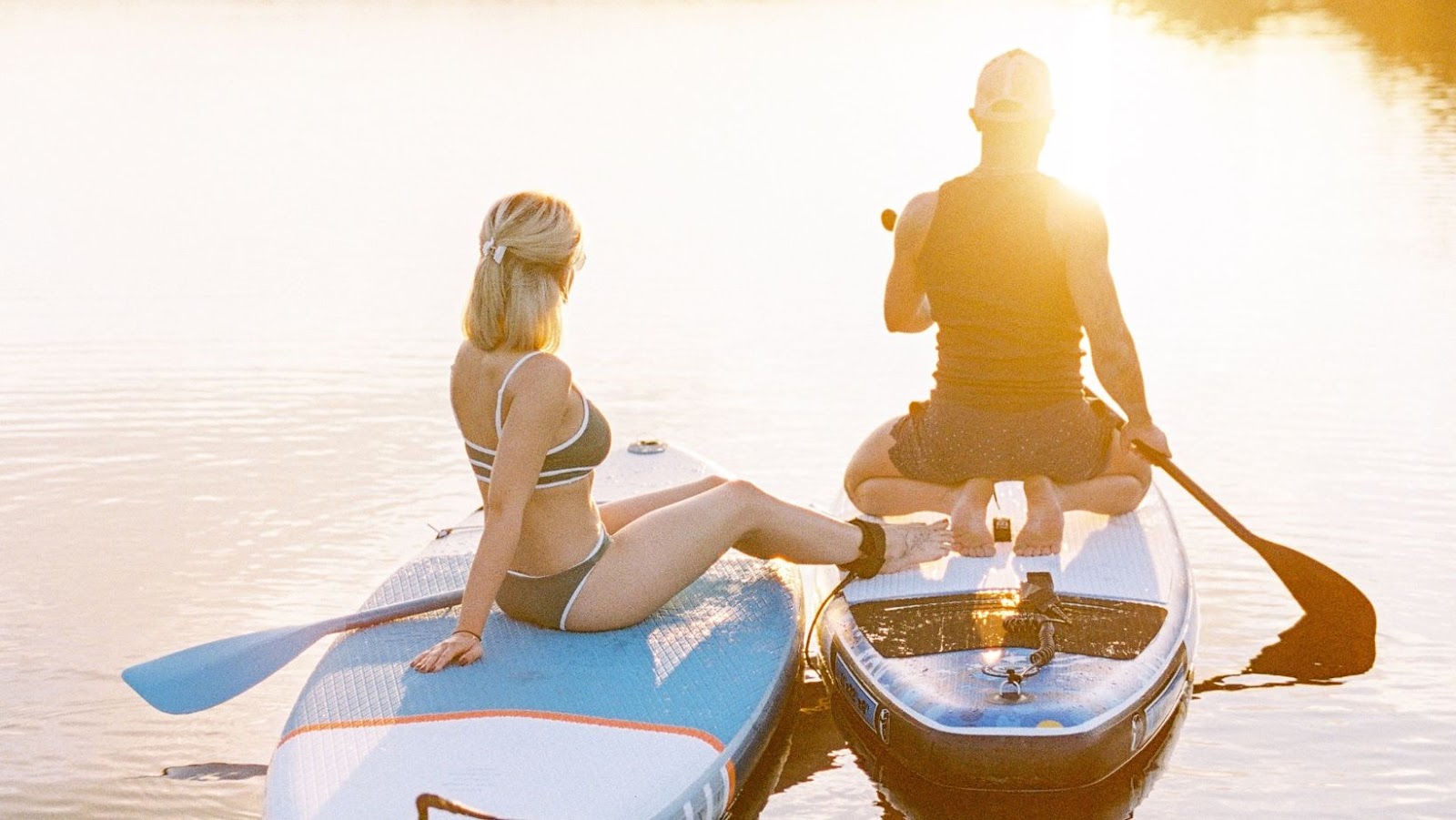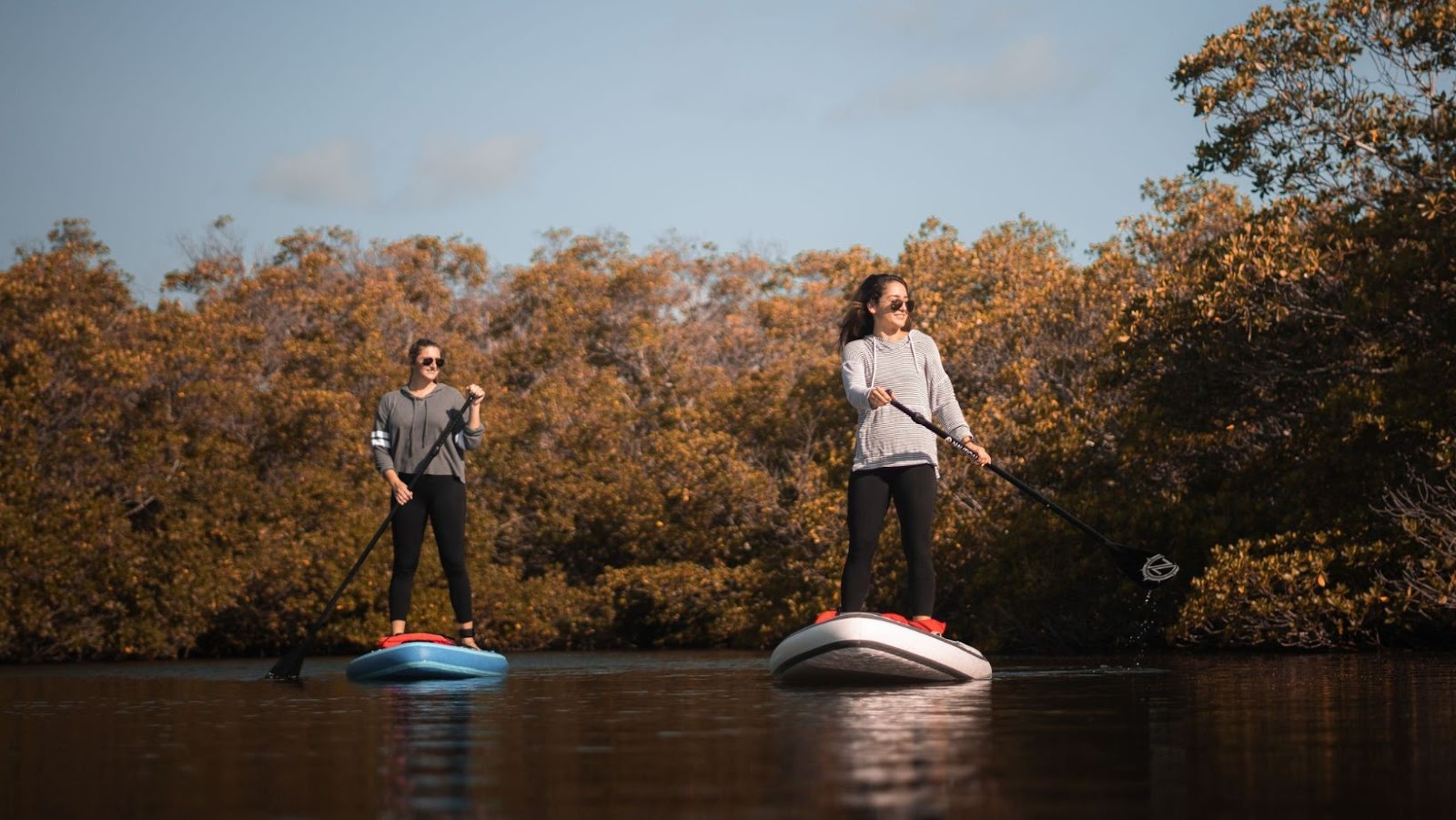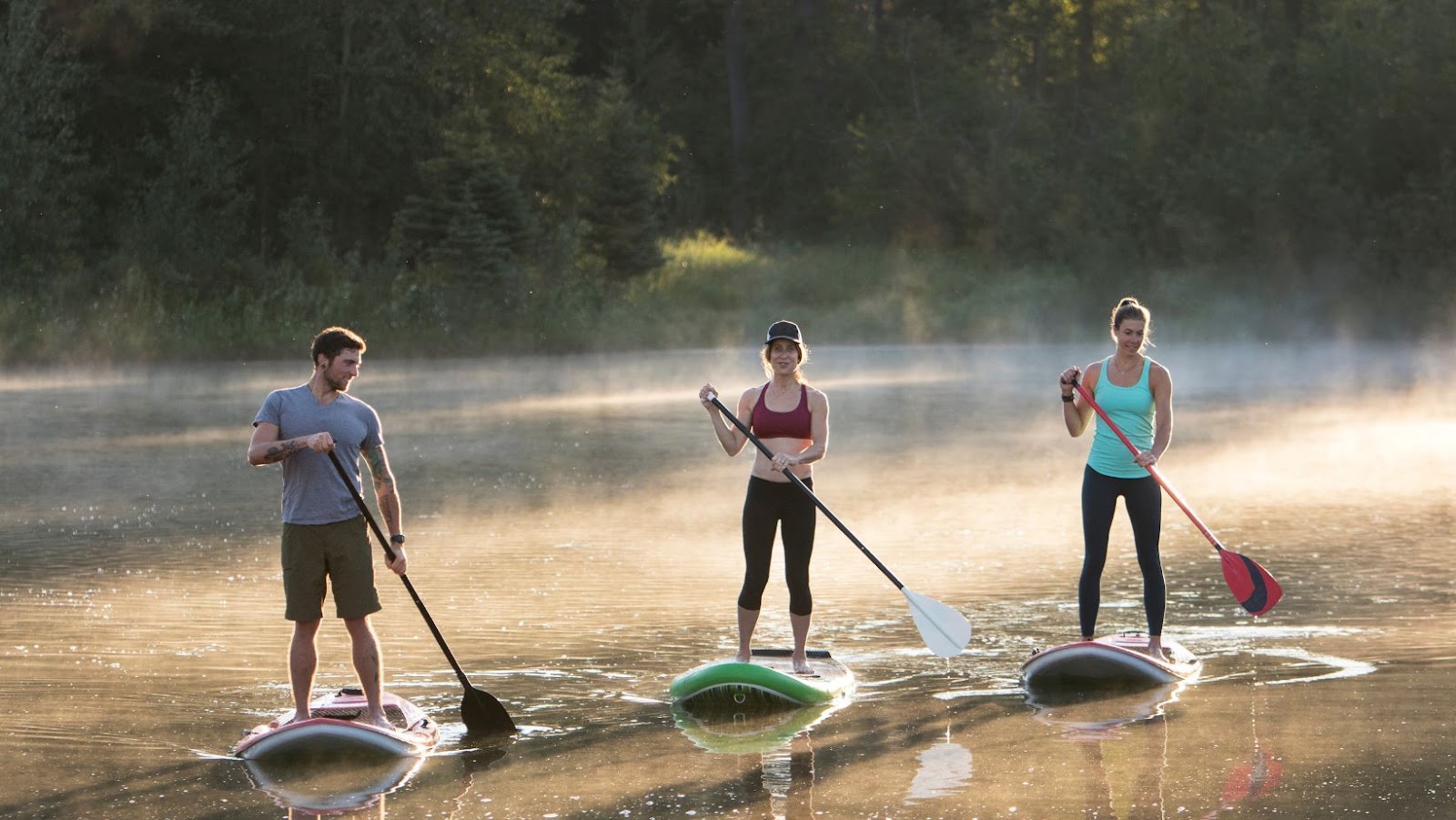Are you itching to hit the water and enjoy a great outdoor experience? Whether it’s paddle boarding or kayaking, both offer great exercise while experiencing the beauty of nature. You have to decide which is best for you – so let’s compare these two water-based activities and see which one wins out!
Introduction to Paddle Boarding and Kayaking
Paddle boarding and kayaking are popular water sports that can be enjoyed by all ages. Whether you are a beginner or an experienced paddler, there is something for everyone when it comes to these sports. Both activities involve the use of specially designed vessels on which the participants stand, or sit, while using a paddle to navigate their way around the water. While similar in many respects, there are some distinct differences between the two activities which you should be aware of before making your choice.
Paddle boarders stand on top of their board, providing them with an elevated view allowing them to fully appreciate the surrounding environment and observe animals in their natural habitat with ease. Unlike kayaking, paddle boards don’t require specialized skills or technical know-how to control and maneuver. Paddle boards are also very light weight making them easy to transport from place-to-place as opposed to bulkier kayaks that often require vehicles for long distances hauling.
Kayaking is an entirely different sport and requires more specialized equipment including paddles specifically crafted for each type of boat as well as protective gear such as life jackets and helmets in certain conditions. In addition, kayakers must deal with currents and wind forces that can cause difficulty when finding balance and stability on the boat for long periods of time. Much like paddle boarding however, kayaking does provide its participants with remarkable views which is further enjoyed through stability guaranteed by having dual pedals secured directly onto vessel itself rather than having one’s legs apart opposed only by supple core strength -as required in paddle boarding-. Because of this increased control built into a craft designed through decades of evolution, enjoying nature while possible sporting actions can be achieved much more swiftly while exploring beach shores or sailing across calm waters at high velocity alike -if appropriate safety measures taken are considered-.
In conclusion Paddle Boarding and Kayaking big provide users with wonderful experiences out on the water no matter if they are a beginner or an expert — have individual requirements depending on what activity you’re looking for – whether it be relaxation or physical exercise — so it’s important to consider each option before making your decision!
Types of Paddle Boards and Kayaks
Paddle boarding and kayaking are two of the most popular water activities, but they involve wildly different equipment. Paddle boards can range anywhere in size from eight feet to fourteen feet and can be tailored to either recreational or performance use. Recreational boards, typically ranging between nine and twelve feet in length, sit lower in the water and provide stability while still maintaining easy maneuverability. Performance boards are usually eleven to fourteen feet long with a pointed noes, which is able to cut through waves under minimal effort from the rider.

Kayaks come in both hard-shell and inflatable varieties, as well as Sit-in or Sit-on-top styles. Sit-on-top kayaks are typically considered more user friendly for beginners since you don’t have to worry about staying inside the boat for balance. The inflatable kayak is becoming an increasingly popular choice for recreational users since it’s light weight, portable, and typically easy to set up. Hard shell kayaks generally offer increased stability and ability at a higher cost.
Many describe kayak paddling as snaking your way across the water with a calculated strokes, while paddleboarding feels more like walking on top of it – while also getting a great core workout!
Paddle Boarding vs Kayaking
The comparison of paddle boarding vs kayaking can seem complex and daunting, but it’s really quite simple to break down. Both paddle boarding and kayaking provide an exciting and enjoyable experience on the water but there are distinct differences between the two activities. This guide will outline the pros and cons of paddling a stand up paddle board (SUP) vs a kayak so you can decide which is best for you.
Paddleboarding Pros: -The upright position is easy and natural feeling, allowing for great visibility while on the water -All fitness levels can have an enjoyable time as SUPs are easy to learn how to use -Stability encourages emergency maneuvering, like stopping or turning quickly in deeper water than you could with a kayak -It’s suitable for all ages, given the stability of boards compared to a typical kayak
Paddleboarding Cons: -Most boards are slow moving compared to their fishtail shaped designs that let larger wave riding SUPs travel faster -The traditional design calls for more leg strength then arms when paddling which can lead to fatigue quicker when directly paddling into windy conditions
Kayaking Pros: -Geared towards those wanting a faster experience on calm or open water surfaces; longer more streamlined hulls provide superior speed -For those that prefer calmer water, framed kayaks offer good stability while still providing an overall speed enhancement when compared to paddle boarding. -Stored energy from strokes travels along, providing excellent tracking ability and directional control with each stroke
Kayaking Cons: -Lower visibility than paddle boards; seats take away some freedom of movement so you’re slightly more stuck in one position when in motion -It’s harder to engage your core muscles while sitting down; this makes it harder to keep in shape while paddling
Physical Requirements for Paddle Boarding and Kayaking
Paddle boarding and kayaking are two popular outdoor activities that allow participants to explore their local waters and take in some beautiful scenery. Both activities can provide a challenging workout and require physical strength and skill to perform. To help you decide which activity is best for you, it’s important to understand the different physical requirements for paddle boarding and kayaking.
Without the necessary strength, paddlers may not have enough power to move their bodyweight and maneuver the board or kayak through the water. The legs are an important muscle group that work to propel the board or kayak forward when on your own, while water resistance provides natural resistance. Upper body strength is also important for paddlers as arm muscles help produce steady strokes and power while trickier maneuvers like turning the board may require more upper body strength.
Core muscles are at work throughout paddle boarding or kayaking as they are continually engaged to ensure balance on the board or in the boat. Core muscles are essential for maintaining stability during these activities as they contract involuntarily when balance is threatened by waves or windy conditions. Your back muscles also come into play to help with speed, as well as maneuvering around obstacles in narrow waterways.
Overall conditioning plays an important role in paddle boarding and kayaking season preparation. Cardiovascular stamina is key for achieving endurance over longer periods of time along with muscular strength and flexibility gained from dynamic warm-ups such as calisthenics before hitting the water. Incorporating some kind of stretching routine into your pre-activity warm-up will work wonders by loosening tight joints while improving posture, stance, technique, control, balance and safety on any watercraft you choose to take out on your adventure!
Comparison of Paddle Boarding and Kayaking
Comparing the cost of the two water sports can be confusing. Depending on the type, size, features and accessories desired, prices can range from relatively inexpensive to high-end.
Before delving into numbers, a few things should be noted:
- For both kayaks and paddle boards (also known as SUP or stand-up paddle boards), rentals are available for those who want to try out either sport before committing to a purchase.
- Manufacturers of both use different materials and have varying levels of construction that might impact pricing.
- When it comes to kayaks, the possibilities for passenger and cargo capacity increases with the price point.
- All prices discussed below are guidelines only and may vary from location to location or retailer to retailer.
Paddle Boarding: Generally speaking, beginner friendly models can cost anywhere from roughly $400-$750 depending on construction and features such as adjustable fin placement, leash attachments and traction pads/deck grips while higher-end models with more advanced features such as carbon fiber paddles may start around $1600 depending on construction materials used. In addition to a board, you will need an adjustable paddle which usually comes included when buying new but averages around $100-$300 if purchased separately. Life jackets usually cost between $20 -$80 while board leashes average around $20 each depending on length requirements desired.

Kayaking: Recreational kayaks can range in price anywhere from roughly $400-$1000 for solo models but may climb higher dependant upon desired paddling style (touring or recreational). Tandem models cost between approximately $500 -$1500 plus accessories such as paddles ($50-$200) life jackets ($30-$120) or boat sprayskirts ($30–$135). Cargo hatches and racks make up additional expenses when applicable so please factor those into your budget if relevant.
Safety Considerations for Paddle Boarding and Kayaking
Whether you’re an experienced paddler or a beginner, safety is an essential factor to consider when engaging in paddle boarding or kayaking activities. Paddle boarding and kayaking are activities that involve potential risks, and it is important to be aware of these before getting onto the water. Before starting any outdoor activity you should take into account the potential
Tips and Tricks for Paddle Boarding and Kayaking
There are several advantages that come with paddle boarding and kayaking, depending on the individual. Paddle boarding is a great way to go at your own pace, take in the surroundings and get some exercise while having fun. Kayaking on the other hand can offer a more intense experience with more speed, as well as being easier to control as you have a paddle in both hands while seated.
When it comes to paddle boarding, it’s important to be aware of water conditions such as currents, obstructions, wind and sun exposure. Proper technique is also essential — stand straight with your feet about hip distance apart and keep your knees slightly bent for balance. To paddle efficiently and ensure you don’t tire yourself out quickly, move the paddle from front to back in a long arc-shaped stroke with each arm alternating each stroke so that you don’t overuse one side of your body.
For kayaking beginners, it is advised to start on calm waters such as lakes or slow-moving rivers rather than taking on riptides or white-water rapids right away. Having a spray skirt (to keep water out of the boat) and wearing a flotation device such as life vest or personal flotation device (PFD) is also essential before getting into a kayak so that you are able remain afloat if needed. To begin paddling, focus on rotating from side to side by holding onto one end of the paddle just wide enough for both hands while moving towards the direction where there will be more power when pulling backthe blade (the curved portion). With this tactic it will be easy to become familiar with different strokes: forward stroke (pulling close to kayak), reverse stroke (pushing away from kayak), sweep stroke (moving paddle away in an arc shape) , drawstroke (pulling toward boat), braces(slapping onto water surface). Make sure you know how operate rudder systems with foot pedals if your kayak has them available too!




No Comment! Be the first one.